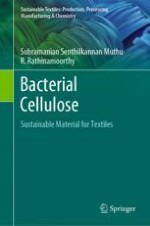2021 | OriginalPaper | Buchkapitel
3. Characteristics of Bacterial Cellulose
Textile and Fashion Perspective
verfasst von : Dr. Subramanian Senthilkannan Muthu, Dr. R. Rathinamoorthy
Erschienen in: Bacterial Cellulose
Verlag: Springer Singapore
Aktivieren Sie unsere intelligente Suche, um passende Fachinhalte oder Patente zu finden.
Wählen Sie Textabschnitte aus um mit Künstlicher Intelligenz passenden Patente zu finden. powered by
Markieren Sie Textabschnitte, um KI-gestützt weitere passende Inhalte zu finden. powered by
